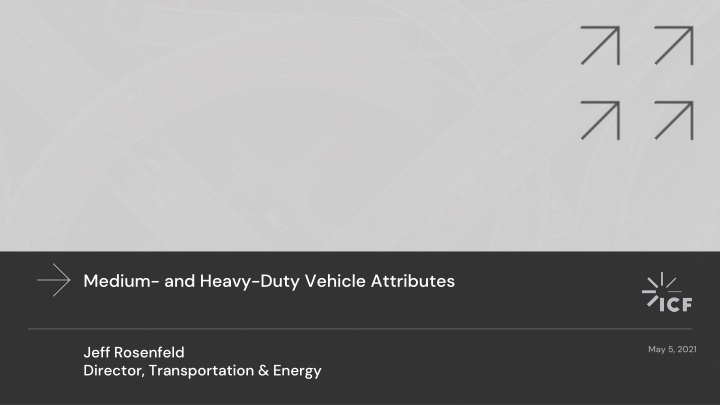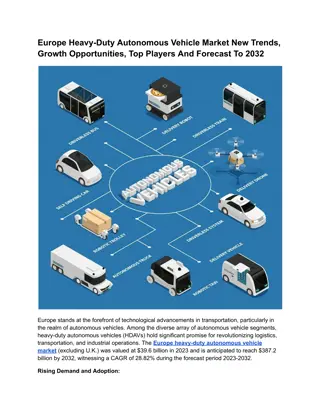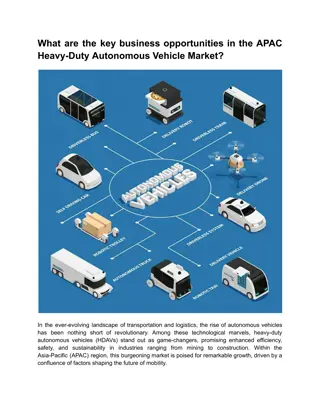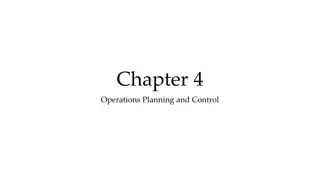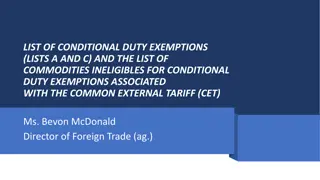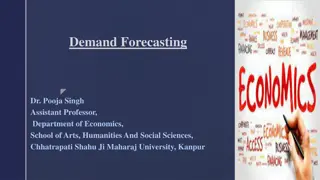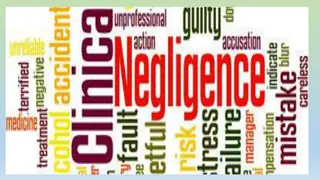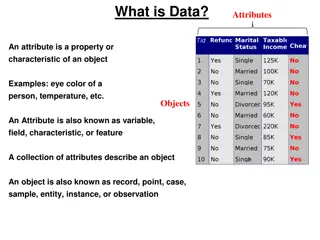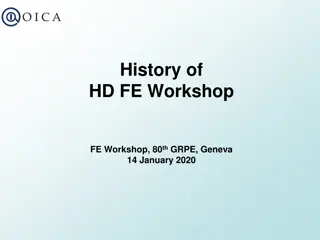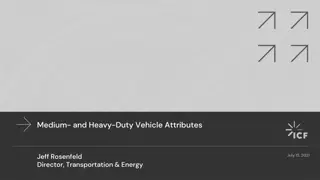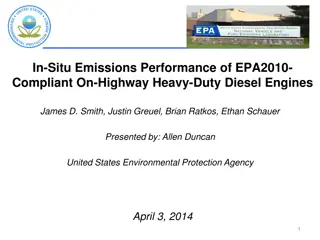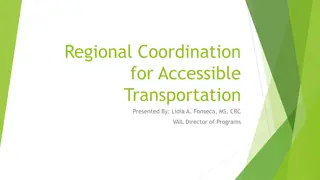Update of Medium- and Heavy-Duty Vehicle Attributes for Energy Commission Transportation Forecasting
This project aims to support the Energy Commission's transportation energy demand forecasting efforts by updating historic and forecast attributes of medium- and heavy-duty vehicles. Tasks include administration, review of past forecast attributes, updating historical vehicle attributes, forecasting vehicle technology, ZEV and Low-NOx infrastructure costs, and training Energy Commission staff.
Download Presentation

Please find below an Image/Link to download the presentation.
The content on the website is provided AS IS for your information and personal use only. It may not be sold, licensed, or shared on other websites without obtaining consent from the author.If you encounter any issues during the download, it is possible that the publisher has removed the file from their server.
You are allowed to download the files provided on this website for personal or commercial use, subject to the condition that they are used lawfully. All files are the property of their respective owners.
The content on the website is provided AS IS for your information and personal use only. It may not be sold, licensed, or shared on other websites without obtaining consent from the author.
E N D
Presentation Transcript
Medium- and Heavy-Duty Vehicle Attributes Jeff Rosenfeld Director, Transportation & Energy May 5, 2021
Purpose: Support Energy Commission transportation energy demand forecasting efforts by updating Purpose: Support Energy Commission transportation energy demand forecasting efforts by updating historic and forecast attributes of medium historic and forecast attributes of medium- - and heavy and heavy- -duty vehicles duty vehicles Subtask 1. Administration Subtask 2. Review of 2019 Forecast Attributes and Matrix of Available Fuel Types Subtask 3. Update Historical Vehicle Attributes Subtask 4. Vehicle Technology Forecast Subtask 5. Forecast ZEV and Low-NOx Fueling/Charging Infrastructure Costs Subtask 6. Forecast Vehicle Attributes Subtask 7. Training Energy Commission Staff Task overview Task overview 2
Methodology Methodology Initial review of previous CEC matrix of technologies and implementation years Literature review and public announcements of the current status of technologies Conversations with MD/HD OEMs about technology status Subtask 2. Review of 2019 Forecast Attributes and Matrix Subtask 2. Review of 2019 Forecast Attributes and Matrix of Available Fuel Types of Available Fuel Types 3
Diesel-Electric Hybrid natural gas Truck Class 2018 electric gasoline hydrogen NG_LNG propane diesel hybrid PHEV GVWR3 Null 2016 1995 Null Null Null 2000 1995 2020 Null GVWR4and5 2010 2016 1995 Null Null 2000 2000 1995 2020 Null GVWR6 2010 2016 1995 2027 Null 2000 2000 1995 Null Null GVWR7 2010 2024 Null Null Null 2003 Null 1995 Null Null GVWR8_SU Null 2024 Null Null 2005 2000 Null 1995 Null 2025 GVWR8 COMBO Null 2021 Null 2022 2007 2007 Null 1995 Null 2025 GVWR8 IRP Null Null Null Null Null 2000 Null 1995 Null Null GVWR8 REFUSE AND RECYCLING 2020 2023 Null Null 2010 2000 Null 1995 Null Null Subtask 2. Review of 2019 Forecast Attributes and Matrix of Subtask 2. Review of 2019 Forecast Attributes and Matrix of Available Fuel Types Available Fuel Types 4
Methodology Methodology Develop baseline fuel economy using EMFAC2021 Review EERs developed by HD Systems and those in GREET 2020 for alternative fuels Gather conventional vehicle prices for top models of each vehicle category from Price Digest and DMV Review cost multipliers developed by HD Systems Examine new literature for incremental costs for alternative fuel vehicles Subtask 3. Update Historical Vehicle Attributes Subtask 3. Update Historical Vehicle Attributes 5
Price data is difficult to determine even for conventional vehicles EERs for hydrogen and hybrids are higher in GREET than calculated by HD Systems Hydrogen Fuel Cell EER comparisons Hydrogen Fuel Cell EER comparisons Vehicle Class Vehicle Class HD HD Systems Systems 1.33 GREET GREET Class 8 Combo Transit Bus 1.45 1.57 1.70 Sunline Transit Agency transit bus demonstration shows 1.70 EER Subtask 3. Update Historical Vehicle Attributes Subtask 3. Update Historical Vehicle Attributes 6
Overview Overview Develop an updated list of vehicle technologies used to calculate forecasts of fuel efficiency and purchase price (Subtask 6) Will reflect recent technological advances, changes in California specific market conditions, and applicable state and federal regulations Include a description of each vehicle technology that is used in the forecast and estimates of the technology s current penetration in the market Will serve to improve the reliability and defensibility of sub-task 6 forecasts Deliverable Vehicle technologies worksheet Subtask 4. Vehicle Technology Forecast Subtask 4. Vehicle Technology Forecast 7
Overview Overview Develop costs for refueling infrastructure based on fuel and average fleet size by year from 2017 - 2035 Potential Data Sources EDF Report ICF/CalETC Report, based on utility filing costs and other sources ANL AFLEET model Other Sources Deliverable worksheet of infrastructure costs by technology, vehicle type, fleet size by year, including itemized costs and rate of fueling/charging Subtask 5. Forecast ZEV and Low Subtask 5. Forecast ZEV and Low- -NOx Fueling/Charging Infrastructure Costs Infrastructure Costs NOx Fueling/Charging 8
Overview Overview Forecast vehicle attributes by technology and fuel for each year between 2017 2035 for sales price, vehicle range, on-road fuel efficiency, maintenance costs, and fuel tank capacity and/or battery capacity Potential data sources BNEF and other sources for trajectory of battery prices ICF/CalETC methodology for sales price described on the follow slide ARB electric trucks report ANL AFLEET model (maintenance, sales costs) Conversations with OEMs Other sources Deliverables Worksheet with attributes by year for each technology/ vehicle size combination Subtask 6. Forecast Vehicle Attributes Subtask 6. Forecast Vehicle Attributes 9
CalETC Electric Truck Forecast Disaggregated current costs of trucks as battery and balance of truck (after removing estimated tariff costs, analysis done in 2019) Developed separate cost reduction trajectories for battery and balance of truck based on BNEF cost reduction trajectories for batteries and CEC demand forecast for balance of truck (need updated data do confirm previous forecast) For each Class 4-8 technologies developed separate curves to estimate cost reductions Subtask 6. Forecast Vehicle Attributes (cont.) Subtask 6. Forecast Vehicle Attributes (cont.) 10
Overview Overview Two trainings facilitated by Aspen with identified CEC staff Trainings will cover the historical and forecasted attributes were developed Subtask 7. Training Energy Commission Staff Subtask 7. Training Energy Commission Staff 11
Schedule Schedule Task Task Status Status Estimated Estimated Completion Completion February 2021 May 2021 May 2021 June 2021 (draft) June 2021 (draft) Task 2 Task 3 Task 4 Task 5 Task 6 Completed On-going Started Not Begun Not Begun Draft completed for Tasks 5 and 6 in June to allow for an editing/updating after initial CEC modeling results 12
